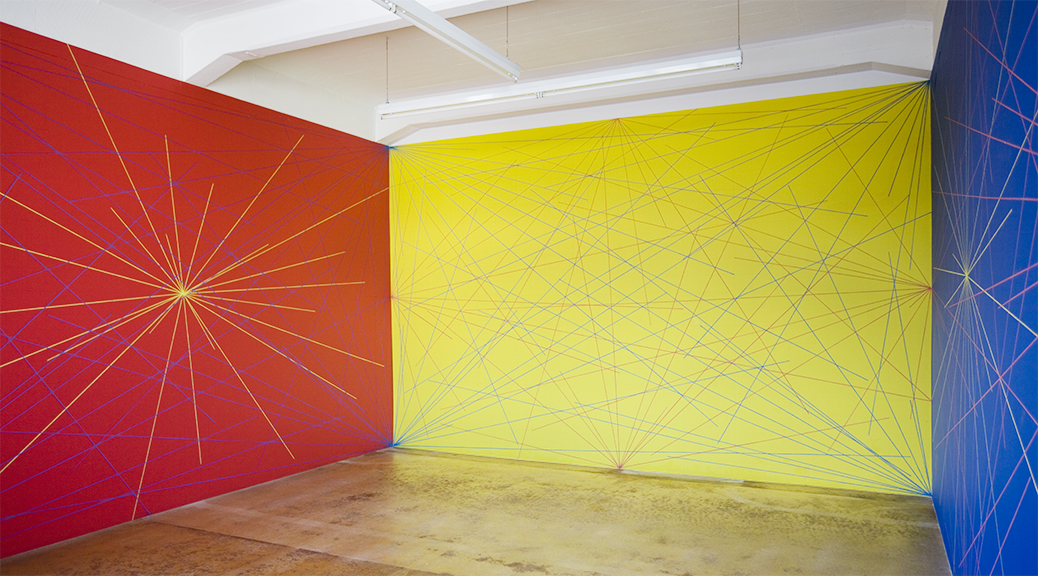Sol LeWitt
Wall Drawing 308, 1978
Raster von ca. 15 cm, das die Wände bedeckt
1. Wand: auf einer roten Wand blaue Linien von jeder Ecke aus zu Rasterpunkten, gelbe Linien vom Zentrum aus zu Rasterpunkten; 2. Wand: auf einer gelben Wand blaue Linien von jeder Ecke aus zu Rasterpunkten, rote Linien vom Mittelpunkt jeder Seite aus zu Rasterpunkten; 3. Wand: auf einer blauen Wand rote Linien vom Mittelpunkt jeder Seite aus zu Rasterpunkten, gelbe Linien vom Zentrum aus zu Rasterpunkten. Die Anzahl der Linien und ihre Länge werden durch den Zeichner bestimmt, aber jede Wand hat die gleiche Anzahl von Linien.
1978 erste Installation: Museum of Modern Art, New York
1983 Hallen für Neue Kunst, Schaffhausen; ausgeführt durch Anthony Sansotta, Markus Ammann, Bettina Roost
Wenn Sie den Titel von LeWitts Werk lesen, wissen Sie theoretisch genau, was es zu sehen gibt. Der Titel liefert die Beschreibung der dreiteiligen Wandzeichnung so präzise, dass er zugleich eine Anweisung zu ihrer Her-
stellung ist. Wenn Sie aber das Werk tatsächlich vor sich haben – und mehr noch: wenn Sie sich hinein begeben – setzt die physische Präsenz dieses Farbraums Ihr Interesse an seinem Konstruktionsprinzip erst einmal ausser Kraft. Dann finden Sie sich von einem Feuerwerk umgeben, das direkt auf Ihre Sinne wirkt. Sie sind in einem Aktionsfeld, dessen Dynamik aus der Beschreibung der rot-gelb-blauen Wände nicht zu erahnen ist.
Dieser Aspekt ist vor dem Hintergrund der Kunstentwicklung von besonderer Bedeutung. Sol LeWitt, „Vater der Konzeptkunst“, hat Ende der 1960er Jahre einflussreiche Schriften publiziert, in denen er die Idee eines Kunst-
werks als dessen wichtigsten Aspekt bezeichnete. Die Ausführung erklärte er zu einer „rein mechanischen Angelegenheit“. Damit löste er eine Öffnung in der Erscheinungsform von Kunst aus, die zeitweise auch zu ihrer Theoretisierung führte. Doch gerade dieses vitale LeWitt-Werk zeigt, wie sehr es der Realisierung der Idee bedarf, um ihre Qualität zu erfahren. Neu dabei ist, dass die Umsetzung unabhängig von der Eigenhändigkeit des Künstlers ist und auf der Basis seines klar formulierten Konzepts auch anderen übertragen werden kann. Die Herstellung des Kunstwerks wird so zu einem kollektiven Prozess, der über Generationen lebendig bleibt.
Finden Sie die Publikation “Sol LeWitt: Wall Drawing 308” (2013) mit einem ausführlichem Text von Christel Sauer in unserem Webshop und erfahren Sie mehr über die drei Jahrzehnte bestehende LeWitt-Einrichtung (1983 – 2014) in den Hallen für Neue Kunst, Schaffhausen auf unserer online Plattform Raussmüller Insights.Sol LeWitt
Wall Drawing 308, 1978
A six-inch grid covering the walls
1st wall: on a red wall, blue lines from each corner to points on the grid, yellow lines from the center to points on the grid; 2nd wall: on a yellow wall, blue lines from each corner to points on the grid, red lines from the midpoint of each side to points on the grid; 3rd wall: on a blue wall, red lines from the midpoint of each side to points on the grid, yellow lines from the center to points on the grid. The number of lines and their length are determined by the draftsman, but each wall has an equal number of lines.
1978 first installation: Museum of Modern Art, New York
1983 Hallen für Neue Kunst, Schaffhausen, drawn by Anthony Sansotta, Markus Ammann, Bettina Roost
Theoretically you already know exactly what you will see when you read the title of LeWitt’s work. The title is such a precise description of the three-part wall drawing that it simultaneously serves as directions for its realization. However, when you stand directly in front of the work – even more, if you enter it – the physical presence of the color space suspends your technical interest in the principles of its construction. You are surrounded by fireworks that directly influence your senses. You feel yourself to be in the midst of a field of action whose dynamics are not to be surmised from the pure description of the red/yellow/blue walls.
Given art’s development, this aspect has special meaning. Sol LeWitt, “father of conceptual art”, published influential texts at the end of the 1960s in which he called the idea of an artwork its most important aspect and its execution “a perfunctory affair”. He thus caused a great opening in the appearance of art, which to an extent also led to its theorization. But it is precisely this vital work by LeWitt that demonstrates how very necessary the realization of the idea is in order to experience its quality. New is that the realization can occur without the artist’s personal involvement and can be assigned to others on the basis of his clearly formulated concept. The realization of the artwork becomes a collective process that remains alive for generations.
Find the publication “Sol LeWitt: Wall Drawing 308” (2013) with an extensive text by Christel Sauer in our webshop and visit our online platform Raussmüller Insights to learn more about the LeWitt installation in the Hallen für Neue Kunst, Schaffhausen, which remained in place for over three decades (1983 – 2014).
